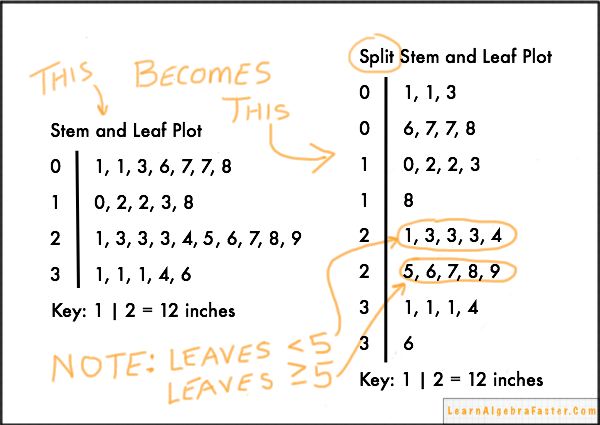

Still, bar charts gave rise to things like stacked bar charts that allow us to visualize observations for multiple investigations that share the same variables so I do not consider them a step backwards. Despite the fact that the histogram chart form *could* be more visually pleasing than the stem and leaf diagram the fact that histograms allow more space for aesthetics means that they can just as easily be uglier, not more appealing, than stem and leaf diagrams. It is not possible to read the actual values out of a colored bar. While bar charts and histograms might be more attractive in some ways, they are, in fact, less data-rich. Stem and leaf diagrams are close cousins of bar charts and histograms. I think Excel had something to do with this, but I am still researching just how it was that the stem and leaf diagram was relegated to the dustbin while the histogram rose to take its place. At some point after typewriters, the stem and leaf diagram morphed into a histogram. All of the values can be read right out of the graph but the device as a whole gives an impression of the overall pattern.Ĥ. The strength of this technique is that it forces the actual dataset into a visually organized diagram.

You see how people (mostly women) could use typewriters to make graphics. Then you’d type a 4, a vertical bar, and 0 1 2 2 3 5 5 6 8. If there were also nine values in the 40s – say 40, 41, 42, 42, 43, 45, 45, 46, and 48 you would hit carriage return. This would mean you would type a 3, then a vertical bar, then 5, 7, and 8.

You will probably have something like three values in the 30s – say, 35, 37, and 38.

So if you are creating a diagram of all the temperatures registered at noon for the month of November, you will have 30 values to stick in your chart. Type in every single observed leaf value for that stem, starting with the lowest one. Then look at all the observations you have for that stem value. Then type a bar or some other vertical device to separate your stem from your leaves. Once you have identified your stems and leaves, type the lowest stem value. It would be possible to use measurements in the hundreds or even thousands.ģ. Thus, the tens spot is the stem and the singles spot is the leaf in this case. If we were measuring temperature, for instance, it would be a lot more likely that the day would have temperatures like 56 and 58 than 60-something and 40-something. For a number like 57, the more durable part of the number is the ‘5’ because even if there was some variation in the measure, the number in the 10’s spot might not change but the ‘7’ in the singles spot is more sensitive and thus more likely to flutter like a leaf. The stem is the more durable part of the number and the leaf is the more sensitive part of the number. Think of each number as having a stem and a leaf. And when I say ‘people’ used to prepare documents, I am actually imagining wives and girlfriends of the husbands and boyfriends who were preparing final drafts of their dissertations and later the (mostly female) secretaries, administrators, and lab assistants typing up articles and figures for (mostly male) professors. It is a rather ingenious graphical device that could be created even with a typewriter, which is how people used to prepare documents not that long ago. The stem and leaf diagram is an old stand-by that has largely been abandoned in social science as it morphed into the histogram.


 0 kommentar(er)
0 kommentar(er)
